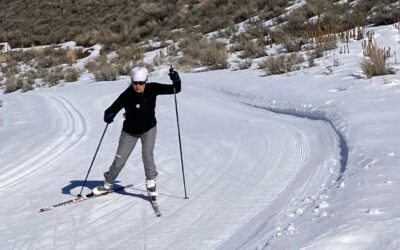This is a question many of us ask ourselves and may struggle to answer. Put more simply, we might say, should I go out and [fill in the blank with your planned exercise/sport] today, or should I stay home and take it easy? Our response depends on the origin of the pain. Below is my answer, told through a recent personal story.
To Ride or Not to Ride?
A few weeks ago, this was my query, whether to go on a challenging bike ride or to stay home. I slept well, but upon rising and taking my first steps, I felt a familiar discomfort in my right foot. It was a tightness on the outside that often became painful during a long ride, what cyclists refer to as a hotspot. Oh shoot! (However, I didn’t say “shoot”!) My mind turned negative, and I began dreading that I would feel this ache most of the ride. Then, as I squatted down on the toilet, my lower back seized—like the pain I’ve felt before when I tried to lift something too heavy. This was the pain that spread across my entire lower back and felt symmetrical on both sides, the kind of pain that stops you instantly and halts your breath. Ouch!
As I sat, my mind raced. It is amazing how fast your thoughts can whiz by, accelerating with each one as they become more and more pessimistic and tragic. Quickly my mind was spinning out of control, creating a dismal portrayal of the future and all the things I would miss out on (like the bike tour in AUS) and the people I would disappoint. After about 30 seconds, maybe a minute, I realized what was happening and intervened to stop the downward thought spiral. I took a deep breath to quiet the internal chatter and stood up. My back was tender, and I automatically moved cautiously (that is one of the functions of pain–alter movement for protection) as I went down the hall to start my morning routine of meditation and posture exercise.
Considering the stressful start to my day, it was impressive that I could calm my mind and slow my breathing. During my 20-minute meditation in the 90-90 position, my back released and my pelvis evened out on the floor. Both were good signs and typical responses for my body. Muscle tightening is a normal protective response for an injury. If something structural had happened in my back, the muscles would not have eased their hold so quickly. I started my exercises gently, and upon feeling no pain, just mild stiffness, completed them all with no issues. My back was feeling much better when I finished. But I still didn’t know if I should ride or not.
To help me decide what to do, I laid on my mat for several minutes and contemplated the start of my day. I felt the foot pain, which instantaneously shifted my mindset to gloom and doom. In this poor mental space, I went to sit and felt searing back pain. Hum? What was going on? My body felt fine lying in bed. It didn’t appear that I had slept in a strange position, and I didn’t feel any soreness as I moved out of the bed. The day before had been mellow, an easy ride in preparation for today’s long effort. Squatting to sit is a common everyday movement, something you and I do numerous times a day. Also, this move in itself would not be sufficient enough to cause any damage and the intense back pain I felt. There was a mismatch between what I did and what I felt. This is an important indicator that the pain did not have a physical cause. Unfortunately, our natural human reaction to pain may always be (regardless of our logical knowledge and training) that something terribly wrong has happened in the joints or tissues of our body–like my initial thought whirlwind. However, we need to consider if what we did could even create such a deep hurt. Surely, sitting down with my own body weight would not have adequate force to do harm. Although, it may be equally or even more difficult to accept that mental factors could create so much pain. Yet, that is the power of our brain. What was on my mind that morning?
To be honest, I wasn’t excited about doing the ride. My husband and I had two big climbs totaling nearly 6000’ planned for the day. The first climb we had done the weekend before and the second climb was of similar intensity. I wasn’t inspired to ride for a few reasons. First, I don’t really like doing the same ride on back-to-back weekends, but it was our final Saturday in Moab for a while and hence our last opportunity to do this ride and reach a goal we had set for ourselves. This created additional pressure, a sense of urgency and obligation. Was I doing this ride because that was my desire, or was I going along and acquiescing to the ride with unacknowledged resentment? Second, I was tired of spending all my weekends biking. There was a couple’s golf tournament that weekend, and we had only played once this season. I missed that! Third, it was going to be hot, not quite triple digits but close. So, I lacked motivation to ride, but why would that make me hurt so bad?
I often attempt to look beyond the pain for the lesson it is trying to teach me. In this example, I believe the pain was forcing a pause moment to make me stop and acknowledge everything that was on my mind. Particularly, the pain was giving me an opportunity to choose. It was providing me with control over my actions. The pain was putting me in charge and making me decide if I truly wanted to do the planned ride that morning.
When we have made arrangements with others or are following a training plan developed by someone else, it can feel as though we have handed over our control. We can feel as though we have no choice. It is an energy of “have to,” not “want to.” My pain was switching the energy back to “want to.” Did I “want to” do this ride or not?
After some additional thought and weighing other options for the day, I concluded that–YES–I did want to do this ride. I felt good with my choice and in my body. I was enlivened to ride. And so I did! Although it was the same route for the first climb, and the second climb was hard and the temperature was high, I enjoyed it all (except the false downhill that bugs me everytime. . .). I never felt the foot pain I feared and wasn’t bothered by my back, barely noticing it again.
Clues it is Psychological Pain
Just as physical pain has certain characteristics, so does pain from mental causes. Here are the clues that my pain was psychologically generated.
- Sudden onset with no injury. Although I have had back pain before, which makes me more susceptible to a recurrence, there was no physical trigger to explain my current flare-up.
- Symmetrical symptoms on the right and left sides of my body. My back pain has always been on the right side. Structural pain generally does not affect the independent sides of the body the same and simultaneously.
- Putting pressure on yourself and people pleasing are typical personality traits that can increase the likelihood of mentally derived pain. (More on personality traits and chronic pain in an upcoming blog.)
- Pressure, obligation, and urgency created the context for the ride, as did the fact that it was a training ride, not a casual spin with friends. And it was my last big ride before a race the following weekend. The greater the consequence of the pain, the more we often hurt.
- Pain that appears during a time of stress. Sometimes this stress can be hidden and subtle as it was for me.
- After gaining an understanding of my pain and heeding its lesson, the physical sensation decreased.
- Reducing my fear of the pain eased the pain. Fear is the fuel for pain. The more you fear the pain, the longer it tends to last. (Related blog: Unlearn Chronic Pain with PRT.
- The pain improved with movement and was nearly gone after cycling. There could be two reasons for this. One, physical causes–the actual cycling with increased blood flow, warming of the tissues, gentle stretching, etc. Two, mental causes–my enhanced mood and reduced stress.
Other questions to ask about your pain:
How long have you had the pain? Structural pain has a predictable healing schedule. If your pain persists beyond that time, it most likely has a psychological element.
How consistent is the pain? Is it always there? Is it always the same intensity? Structural pain is consistent, whereas pain with a mental origin can vary greatly. Additionally, pain that spreads or shifts back and forth between different areas of the body also tends to have cognitive roots.
What triggers your pain? Pain that occurs in response to stress or anything unrelated to the body–location, sound, smell–is generally psychologically driven.
Conclusion
When it comes to pain, our biggest concern is making it worse and risking more damage and downtime. Psychologically generated pain can be equivalent to or more debilitating than pain from physical causes. Pain derived from mental concepts exerts no damage on the body. Knowing the origin of your pain increases your sense of safety and can free you to move and play. The next time you hurt, summon your inner Sherlock Holmes and inspect the clues to discern the source of your pain.
Pain Reprocessing Therapy Center Course
Schubiner, H., Betzold, M. (2019). Unlearn your pain: A 28-day process to reprogram your brain. Mind Body Publishing.
Butler, D. S., Moseley, G. L. (2013). Explain Pain (2nd ed.). Noigroup Publications.



